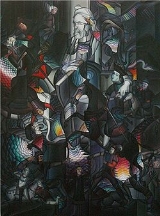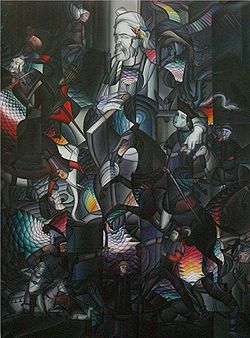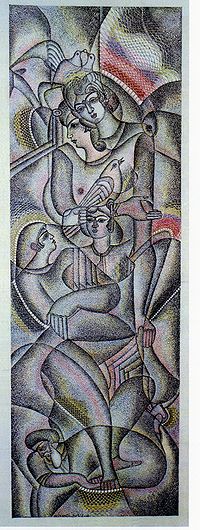
Bahram Alivandi
Encyclopedia
Bahram Alivandi is an Iranian-born Modern artist living in Vienna
, Austria
. He is known primarily for his painting
s, which typically depict stories from Persian
mythology and literature, and express oriental mysticism. He has also produced a number of wall tapestries
that, like his works on canvas, demonstrate his own instantly recognisable visual language.
 Alivandi was born in Fars Province in the South of Iran
Alivandi was born in Fars Province in the South of Iran
in 1928. He gained his artistic training in Tehran
, initially at the Kamal-ol-Molk
Academy of Art, then under the tuition of French masters at Tehran's School of Fine Arts (closely modeled on the French École des Beaux-Arts
), from which he graduated with distinction. He completed a further degree in painting at the College of Decorative Arts, Tehran.
In 1959 he was appointed by the Ministry of Education, teaching painting at the Workshop of National Art and the Kamal-ol-Molk Academy of Art, a post that he held for 20 years. During this time he practiced a variety of traditional Persian arts such as the Miniature
, Ceramics
, Tapestries
, and Silversmithery.
During this time Alivandi was one of Iran's leading modernists, but he left Iran several years after the Islamic revolution of 1979
to escape the repression and censorisation of all free artistic expression.
He has lived and worked in Vienna since 1983.
Alivandi belongs to a respected generation of Iranian artists who are important figures in contemporary Iranian art, including Massoud Arabshahi
, Nasser Ovissi, and Parviz Tanavoli
, to all of whom he is well known.
 Alivandi's work is rich in symbolism and oriental motifs, such as the fish, gazelle, and horse, which are traditional motifs of Persian miniatures. He draws influence from Persian culture, depicting characters and stories from legends and epic poetry by important figures like Ferdowsi
Alivandi's work is rich in symbolism and oriental motifs, such as the fish, gazelle, and horse, which are traditional motifs of Persian miniatures. He draws influence from Persian culture, depicting characters and stories from legends and epic poetry by important figures like Ferdowsi
and Farid ad-Din Attar. Outstanding works include a series of large-scale oil paintings executed in the 1980s which depict such important figures as Mithra
, Jesus Christ, the Simorgh
, and Ferdowsi
himself. Some of his work is influenced by the war situation and the repression of his native Iran, and expresses the pain and suffering of his people.
In terms of technique his work is at times traditional and at times highly original. Alivandi's early paintings, including those from the 1980s, use the now-traditional medium of oil on canvas, yet his aesthetic style, which recalls the stained glass of medieval churches, is highly personal. During the 1990s Alivandi continued to work in oils, but abandoned the traditional canvas, choosing instead to apply his paints directly to newspaper; a method pioneered by the cubists
in the early 1900s.
Since circa 2000, he increasingly works with the angelique pointillage technique (as seen in the image on the right), a unique method of painting with extremely small dots of ink which are then covered with a layer of veneer to lock and intensify the colours. This innovative pointillist
technique has resulted in the many striking works that demonstrate the beauty of his composition and the power of his vision. According to one critic, his masterful blending of hues has earned him the title "the magician of colours".
Alivandi's paintings are typically on a large scale, yet even so they demonstrate the immense skill of his hand in their intricate detail.
 Alivandi's work has been exhibited throughout Europe and Asia, and have received high critical acclaim. Important recent exhibitions include:
Alivandi's work has been exhibited throughout Europe and Asia, and have received high critical acclaim. Important recent exhibitions include:
Selected solo:
Selected group:
Vienna
Vienna is the capital and largest city of the Republic of Austria and one of the nine states of Austria. Vienna is Austria's primary city, with a population of about 1.723 million , and is by far the largest city in Austria, as well as its cultural, economic, and political centre...
, Austria
Austria
Austria , officially the Republic of Austria , is a landlocked country of roughly 8.4 million people in Central Europe. It is bordered by the Czech Republic and Germany to the north, Slovakia and Hungary to the east, Slovenia and Italy to the south, and Switzerland and Liechtenstein to the...
. He is known primarily for his painting
Painting
Painting is the practice of applying paint, pigment, color or other medium to a surface . The application of the medium is commonly applied to the base with a brush but other objects can be used. In art, the term painting describes both the act and the result of the action. However, painting is...
s, which typically depict stories from Persian
Persian literature
Persian literature spans two-and-a-half millennia, though much of the pre-Islamic material has been lost. Its sources have been within historical Persia including present-day Iran as well as regions of Central Asia where the Persian language has historically been the national language...
mythology and literature, and express oriental mysticism. He has also produced a number of wall tapestries
Tapestry
Tapestry is a form of textile art, traditionally woven on a vertical loom, however it can also be woven on a floor loom as well. It is composed of two sets of interlaced threads, those running parallel to the length and those parallel to the width ; the warp threads are set up under tension on a...
that, like his works on canvas, demonstrate his own instantly recognisable visual language.
Biography

Iran
Iran , officially the Islamic Republic of Iran , is a country in Southern and Western Asia. The name "Iran" has been in use natively since the Sassanian era and came into use internationally in 1935, before which the country was known to the Western world as Persia...
in 1928. He gained his artistic training in Tehran
Tehran
Tehran , sometimes spelled Teheran, is the capital of Iran and Tehran Province. With an estimated population of 8,429,807; it is also Iran's largest urban area and city, one of the largest cities in Western Asia, and is the world's 19th largest city.In the 20th century, Tehran was subject to...
, initially at the Kamal-ol-Molk
Kamal-ol-molk
Mohammad Ghaffari , better known as Kamal-ol-Molk , was an Iranian painter and part of the Ghaffari Clan in Kashan.-Biography:...
Academy of Art, then under the tuition of French masters at Tehran's School of Fine Arts (closely modeled on the French École des Beaux-Arts
École des Beaux-Arts
École des Beaux-Arts refers to a number of influential art schools in France. The most famous is the École nationale supérieure des Beaux-Arts, now located on the left bank in Paris, across the Seine from the Louvre, in the 6th arrondissement. The school has a history spanning more than 350 years,...
), from which he graduated with distinction. He completed a further degree in painting at the College of Decorative Arts, Tehran.
In 1959 he was appointed by the Ministry of Education, teaching painting at the Workshop of National Art and the Kamal-ol-Molk Academy of Art, a post that he held for 20 years. During this time he practiced a variety of traditional Persian arts such as the Miniature
Persian miniature
A Persian miniature is a small painting on paper, whether a book illustration or a separate work of art intended to be kept in an album of such works called a muraqqa. The techniques are broadly comparable to the Western and Byzantine traditions of miniatures in illuminated manuscripts...
, Ceramics
Iranian pottery
Iranian pottery or Persian pottery production presents a continuous history from the beginning of Iranian history until the present day....
, Tapestries
Tapestry
Tapestry is a form of textile art, traditionally woven on a vertical loom, however it can also be woven on a floor loom as well. It is composed of two sets of interlaced threads, those running parallel to the length and those parallel to the width ; the warp threads are set up under tension on a...
, and Silversmithery.
During this time Alivandi was one of Iran's leading modernists, but he left Iran several years after the Islamic revolution of 1979
Iranian Revolution
The Iranian Revolution refers to events involving the overthrow of Iran's monarchy under Shah Mohammad Reza Pahlavi and its replacement with an Islamic republic under Ayatollah Ruhollah Khomeini, the leader of the...
to escape the repression and censorisation of all free artistic expression.
He has lived and worked in Vienna since 1983.
Alivandi belongs to a respected generation of Iranian artists who are important figures in contemporary Iranian art, including Massoud Arabshahi
Massoud Arabshahi
Massoud Arabshahi , born Tehran, Iran, 1935 is an Iranian painter.Arabshahi held his first solo exhibition at the Iran-India Centre, Tehran, in 1964, four years before graduating from the College of Decorative Arts, Tehran...
, Nasser Ovissi, and Parviz Tanavoli
Parviz Tanavoli
Parviz Tanavoli is an Iranian sculptor now residing in Canada. He was born in Tehran, Iran in 1937.-Academic career:Upon graduating from the Brera Academy of Milan in 1959, Tanavoli taught sculpture for three years at the Minneapolis College of Art and Design...
, to all of whom he is well known.
Artistic style

Ferdowsi
Ferdowsi was a highly revered Persian poet. He was the author of the Shahnameh, the national epic of Iran and related societies.The Shahnameh was originally composed by Ferdowsi for the princes of the Samanid dynasty, who were responsible for a revival of Persian cultural traditions after the...
and Farid ad-Din Attar. Outstanding works include a series of large-scale oil paintings executed in the 1980s which depict such important figures as Mithra
Mithra
Mithra is the Zoroastrian divinity of covenant and oath. In addition to being the divinity of contracts, Mithra is also a judicial figure, an all-seeing protector of Truth, and the guardian of cattle, the harvest and of The Waters....
, Jesus Christ, the Simorgh
Simurgh
Simurgh , also spelled simorgh, simurg, simoorg or simourv, also known as Angha , is the modern Persian name for a benevolent, mythical flying creature...
, and Ferdowsi
Ferdowsi
Ferdowsi was a highly revered Persian poet. He was the author of the Shahnameh, the national epic of Iran and related societies.The Shahnameh was originally composed by Ferdowsi for the princes of the Samanid dynasty, who were responsible for a revival of Persian cultural traditions after the...
himself. Some of his work is influenced by the war situation and the repression of his native Iran, and expresses the pain and suffering of his people.
In terms of technique his work is at times traditional and at times highly original. Alivandi's early paintings, including those from the 1980s, use the now-traditional medium of oil on canvas, yet his aesthetic style, which recalls the stained glass of medieval churches, is highly personal. During the 1990s Alivandi continued to work in oils, but abandoned the traditional canvas, choosing instead to apply his paints directly to newspaper; a method pioneered by the cubists
Cubism
Cubism was a 20th century avant-garde art movement, pioneered by Pablo Picasso and Georges Braque, that revolutionized European painting and sculpture, and inspired related movements in music, literature and architecture...
in the early 1900s.
Since circa 2000, he increasingly works with the angelique pointillage technique (as seen in the image on the right), a unique method of painting with extremely small dots of ink which are then covered with a layer of veneer to lock and intensify the colours. This innovative pointillist
Pointillism
Pointillism is a technique of painting in which small, distinct dots of pure color are applied in patterns to form an image. Georges Seurat developed the technique in 1886, branching from Impressionism. The term Pointillism was first coined by art critics in the late 1880s to ridicule the works...
technique has resulted in the many striking works that demonstrate the beauty of his composition and the power of his vision. According to one critic, his masterful blending of hues has earned him the title "the magician of colours".
Alivandi's paintings are typically on a large scale, yet even so they demonstrate the immense skill of his hand in their intricate detail.
Exhibitions

Selected solo:
- Alivandi's work has been shown at the Headquarters of the United NationsUnited NationsThe United Nations is an international organization whose stated aims are facilitating cooperation in international law, international security, economic development, social progress, human rights, and achievement of world peace...
in Vienna. - 'Art in Exile', a one-man show in Vienna in June 2007, consisting of 73 works of watercolour, oil on canvas, and works on paper.
Selected group:
- In 2008 in Vienna, a highly significant exhibition organised by UNESCOUNESCOThe United Nations Educational, Scientific and Cultural Organization is a specialized agency of the United Nations...
included Ferdowsi - an important work by Alivandi which depicts the ShahnamehShahnamehThe Shahnameh or Shah-nama is a long epic poem written by the Persian poet Ferdowsi between c.977 and 1010 AD and is the national epic of Iran and related societies...
, an enormous poetic opus written by the Iranian poet FerdowsiFerdowsiFerdowsi was a highly revered Persian poet. He was the author of the Shahnameh, the national epic of Iran and related societies.The Shahnameh was originally composed by Ferdowsi for the princes of the Samanid dynasty, who were responsible for a revival of Persian cultural traditions after the...
around 1000 CE that is the national epic of the Persian-speaking world. - In December 2007 in Paris, Alivandi was exhibited alongside two French artists at Galerie Art Présent, one of Paris's foremost galleries of contemporary art. Following the exhibition, in January 2008, a French article entitled 'Un grand peintre en exile' ('A great painter in exile') wrote that Alivandi's "synthesis of European training with sixty years of artistic experience derived from a deep knowledge of Persian art and spirituality, has resulted in the creation of a new genre that is unique to him." This critic also noted that Alivandi's paintings represent a "paradise of dots".
Prizes
- Stockholm, 1994: Alivandi won First Prize at the 1st International Graphic Art Exhibition, an annual juried show in StockholmStockholmStockholm is the capital and the largest city of Sweden and constitutes the most populated urban area in Scandinavia. Stockholm is the most populous city in Sweden, with a population of 851,155 in the municipality , 1.37 million in the urban area , and around 2.1 million in the metropolitan area...
, SwedenSwedenSweden , officially the Kingdom of Sweden , is a Nordic country on the Scandinavian Peninsula in Northern Europe. Sweden borders with Norway and Finland and is connected to Denmark by a bridge-tunnel across the Öresund....
.

